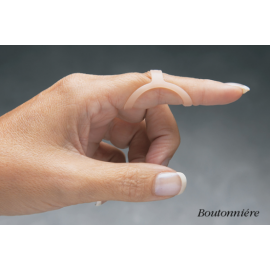How To Wear the Oval-8 Finger Splint
How To Wear the Oval-8 Finger Splint
The Oval-8 Finger Splint is a versatile support designed for immobilising and stabilising an injured or deformed finger joint. As it is such a versatile splint, it can be used to support a wide range of conditions affecting the finger joints, such as arthritis, mallet finger, swan neck, boutonniere deformity, hypermobility, etc. This article helps you to learn about the different ways to wear the Oval-8 Finger Splint for specific conditions.
Please note that the Oval-8 Finger Splint is suitable for a range of different ailments, and this article is not exhaustive. If you are unsure about whether the Oval-8 Finger Splint is right for you, we recommend you consult your doctor or other medical professional first.
Oval-8 Finger Splint for Mallet Finger

Mallet finger is one of the most common finger injuries, and this can be treated with the Oval-8 Finger Splint. The Oval-8 can be worn on the distal interphalangeal (DIP) joint, as shown below, to hold the joint in extension or slight hyperextension.
Oval-8 Finger Splint for Trigger Finger

When suffering from trigger finger, it's important to limit metacarpophalangeal (MCP) and interphalangeal (IP) joint inflexion. The Oval-8 can be used for this by wearing the Oval-8 nearer the base of the finger to prevent the finger from being able to bend too far down towards the palm. Wearing the finger splint this way is also useful following injection.
Oval-8 Finger Splint for Trigger Thumb

The Oval-8 Splint is also suitable for wearing on the thumb. This can treat trigger thumb in the same way that trigger finger is treated, preventing the bending of the thumb at the MCP and IP joints.
Oval-8 Finger Splint for Swan Neck Deformity

If you suffer from swan neck (hyperextension) deformity, it is recommended that the Oval-8 split is worn with the bar underneath your joint, and with your proximal interphalangeal (PIP) joint, often referred to as next to your second knuckle, comfortably in the opening of the finger splint. This stops PIP joint extension, while also improving your control over your DIP joint (next to the knuckle nearest the fingernail).
Oval-8 Finger Splint for Boutonniere Deformity

Boutonniere deformity refers to the condition when the tendons that straighten the middle joint of your finger become deformed. This prevents your finger from straightening, but with the Oval-8 Finger Splint you can ensure your finger remains held in a neutral extension.
This is also a useful position as a retainer following dynamic splinting to solidify gains in range of motion.
Oval-8 Finger Splint for Lateral Deviated Fingers

Lateral deviation is where the joint begins to deviate sideways, and this can often be caused by an injury or arthritis. Wearing with Oval-8 against the deviating joint may help to prevent this from worsening, and pressure can be applied ulnarly or radially (i.e. on either side of the finger) to reduce this movement.
Oval-8 Finger Splint for Fractures

If you've suffered from a fracture, then wearing two Oval-8 splints on the one joint will stabilise the minor non-displaced fracture by holding it in place.
It is advised that you wear a larger-sized splint on the underside of your finger, and interlock this with a smaller-sized splint on the top for effective immobilisation.
Finding the size of your oval-8
Sizes correspond to jeweler’s ring sizes, though correlation may vary due to swelling or joint changes.you may measure the circumference of the finger:

Buy now at: https://rehabshop.com.sg/support-brace/oval-8-finger-splint


